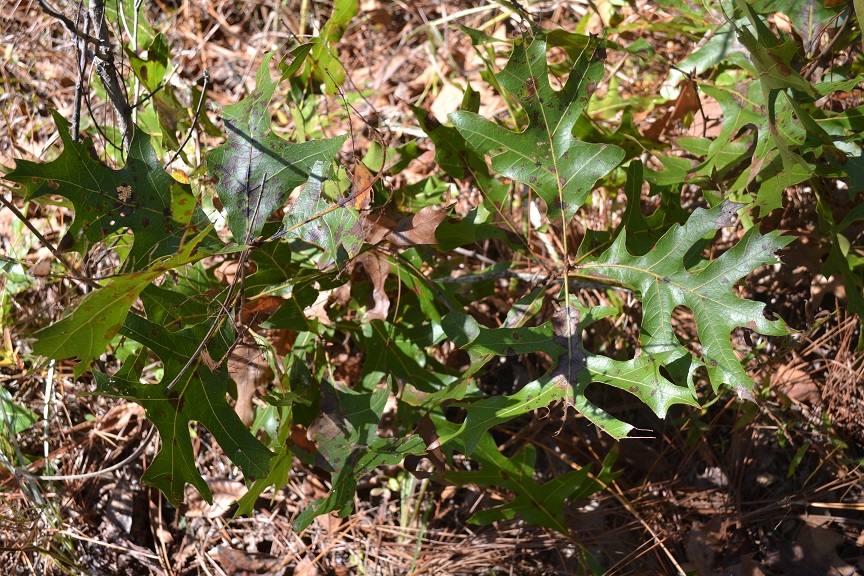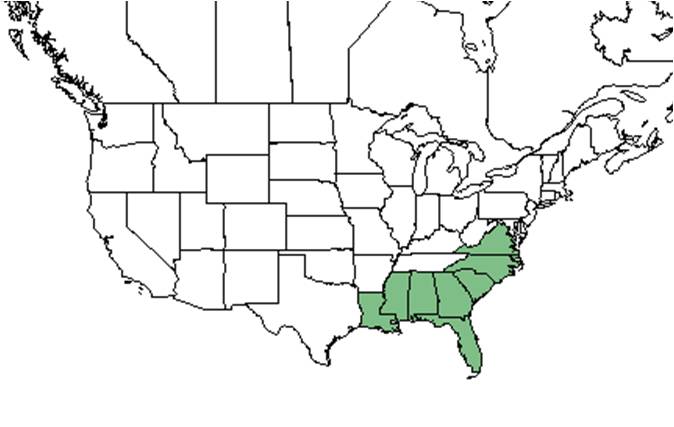Difference between revisions of "Quercus laevis"
(→Ecology) |
|||
| Line 30: | Line 30: | ||
===Habitat=== <!--Natural communities, human disturbed habitats, topography, hydrology, soils, light, fire regime requirements for removal of competition, etc.--> | ===Habitat=== <!--Natural communities, human disturbed habitats, topography, hydrology, soils, light, fire regime requirements for removal of competition, etc.--> | ||
''Quercus laevis'' is restricted to native groundcover with a statistical affinity in upland pinelands of South Georgia.<ref name=ost>Ostertag, T.E., and K.M. Robertson. 2007. A comparison of native versus old-field vegetation in upland pinelands managed with frequent fire, South Georgia, USA. Pages 109–120 in R.E. Masters and K.E.M. Galley (eds.). Proceedings of the 23rd Tall Timbers Fire Ecology Conference: Fire in Grassland and Shrubland Ecosystems.</ref> | ''Quercus laevis'' is restricted to native groundcover with a statistical affinity in upland pinelands of South Georgia.<ref name=ost>Ostertag, T.E., and K.M. Robertson. 2007. A comparison of native versus old-field vegetation in upland pinelands managed with frequent fire, South Georgia, USA. Pages 109–120 in R.E. Masters and K.E.M. Galley (eds.). Proceedings of the 23rd Tall Timbers Fire Ecology Conference: Fire in Grassland and Shrubland Ecosystems.</ref> | ||
| − | ''Q. laevis'' responds negatively to agriculture-based soil disturbance in historically longleaf forest communities.<ref>Brudvig, L.A. and E.I. Damchen. (2011). Land-use history, historical connectivity, and land management interact to determine longleaf pine woodland understory richness and composition. Ecography 34: 257-266.</ref> It also responds negatively to agricultural-based soil disturbance in South Carolina coastal plain communities. This marks it as a possible indicator species for remnant woodland.<ref>Brudvig, L.A., E Grman, C.W. Habeck, and J.A. Ledvina. (2013). Strong legacy of agricultural land use on soils and understory plant communities in longleaf pine woodlands. Forest Ecology and Management 310: 944-955.</ref><ref>Brudvig, L.A., J.L. Orrock, E.I. Damschen, C.D. Collins, P.G. Hahn, W.B. Mattingly, J.W. Veldman, and J.L. Walker. (2014). Land-Use History and Contemporary Management Inform an Ecological Reference Model for Longleaf Pine Woodland Understory Plant Communities. PLoS ONE 9(1): e86604.</ref> It also responds positively to roller chopping in West Florida with an overall increase in density.<ref>Burns, R.M. and R.D. McReynolds. (1972). Scheduling and Intensity of Site Preparation for Pine in West Florida Sandhills. Journal of Forestry 70(12):737-740.</ref> When exposed to soil disturbance by military training in West Georgia, ''Q. laevis'' responds negatively by way of absence.<ref>Dale, V.H., S.C. Beyeler, and B. Jackson. (2002). Understory vegetation indicators of anthropogenic disturbance in longleaf pine forests at Fort Benning, Georgia, USA. Ecological Indicators 1(3):155-170.</ref> ''Q. laevis'' responds negatively to soil disturbance by roller chopping in Northwest Florida sandhills.<ref>Hebb, E.A. (1971). Site Preparation Decreases Game Food Plants in Florida Sandhills. The Journal of Wildlife Management 35(1):155-162.</ref>''Quercus laevis'' is frequent and abundant in the Peninsula Xeric Sandhills and Panhandle Xeric Sandhills community types as described in Carr et al. (2010).<ref>Carr, S.C., K.M. Robertson, and R.K. Peet. 2010. A vegetation classification of fire-dependent pinelands of Florida. Castanea 75:153-189.</ref> | + | ''Q. laevis'' responds negatively to agriculture-based soil disturbance in historically longleaf forest communities.<ref>Brudvig, L.A. and E.I. Damchen. (2011). Land-use history, historical connectivity, and land management interact to determine longleaf pine woodland understory richness and composition. Ecography 34: 257-266.</ref> It also responds negatively to agricultural-based soil disturbance in South Carolina coastal plain communities. This marks it as a possible indicator species for remnant woodland.<ref>Brudvig, L.A., E Grman, C.W. Habeck, and J.A. Ledvina. (2013). Strong legacy of agricultural land use on soils and understory plant communities in longleaf pine woodlands. Forest Ecology and Management 310: 944-955.</ref><ref>Brudvig, L.A., J.L. Orrock, E.I. Damschen, C.D. Collins, P.G. Hahn, W.B. Mattingly, J.W. Veldman, and J.L. Walker. (2014). Land-Use History and Contemporary Management Inform an Ecological Reference Model for Longleaf Pine Woodland Understory Plant Communities. PLoS ONE 9(1): e86604.</ref> It also responds positively to roller chopping in West Florida with an overall increase in density.<ref>Burns, R.M. and R.D. McReynolds. (1972). Scheduling and Intensity of Site Preparation for Pine in West Florida Sandhills. Journal of Forestry 70(12):737-740.</ref> When exposed to soil disturbance by military training in West Georgia, ''Q. laevis'' responds negatively by way of absence.<ref>Dale, V.H., S.C. Beyeler, and B. Jackson. (2002). Understory vegetation indicators of anthropogenic disturbance in longleaf pine forests at Fort Benning, Georgia, USA. Ecological Indicators 1(3):155-170.</ref> ''Q. laevis'' responds negatively to soil disturbance by roller chopping in Northwest Florida sandhills.<ref>Hebb, E.A. (1971). Site Preparation Decreases Game Food Plants in Florida Sandhills. The Journal of Wildlife Management 35(1):155-162.</ref> ''Quercus laevis'' is frequent and abundant in the Peninsula Xeric Sandhills and Panhandle Xeric Sandhills community types as described in Carr et al. (2010).<ref>Carr, S.C., K.M. Robertson, and R.K. Peet. 2010. A vegetation classification of fire-dependent pinelands of Florida. Castanea 75:153-189.</ref> |
| + | |||
===Phenology=== <!--Timing off flowering, fruiting, seed dispersal, and environmental triggers. Cite PanFlora website if appropriate: http://www.gilnelson.com/PanFlora/ --> | ===Phenology=== <!--Timing off flowering, fruiting, seed dispersal, and environmental triggers. Cite PanFlora website if appropriate: http://www.gilnelson.com/PanFlora/ --> | ||
''Quercus laevis'' has been observed to flower from March to June.<ref>Nelson, G. [http://www.gilnelson.com/ PanFlora]: Plant data for the eastern United States with emphasis on the Southeastern Coastal Plains, Florida, and the Florida Panhandle. www.gilnelson.com/PanFlora/ Accessed: 19 MAY 2021</ref> | ''Quercus laevis'' has been observed to flower from March to June.<ref>Nelson, G. [http://www.gilnelson.com/ PanFlora]: Plant data for the eastern United States with emphasis on the Southeastern Coastal Plains, Florida, and the Florida Panhandle. www.gilnelson.com/PanFlora/ Accessed: 19 MAY 2021</ref> | ||
Revision as of 13:12, 8 June 2021
| Quercus laevis | |
|---|---|

| |
| Photo by Kevin Robertson | |
| Scientific classification | |
| Kingdom: | Plantae |
| Division: | Tracheophyta- Vascular plants |
| Class: | Magnoliopsida - Dicotyledons |
| Order: | Fagales |
| Family: | Fagaceae |
| Genus: | Quercus |
| Species: | Q. laevis |
| Binomial name | |
| Quercus laevis Walter | |

| |
| Natural range of Quercus laevis from USDA NRCS Plants Database. | |
Common name: Turkey oak
Contents
Taxonomic notes
Synonym: Quercus catesbaei Michaux
Description
A description of Quercus laevis is provided in The Flora of North America.
Distribution
Ecology
Habitat
Quercus laevis is restricted to native groundcover with a statistical affinity in upland pinelands of South Georgia.[1] Q. laevis responds negatively to agriculture-based soil disturbance in historically longleaf forest communities.[2] It also responds negatively to agricultural-based soil disturbance in South Carolina coastal plain communities. This marks it as a possible indicator species for remnant woodland.[3][4] It also responds positively to roller chopping in West Florida with an overall increase in density.[5] When exposed to soil disturbance by military training in West Georgia, Q. laevis responds negatively by way of absence.[6] Q. laevis responds negatively to soil disturbance by roller chopping in Northwest Florida sandhills.[7] Quercus laevis is frequent and abundant in the Peninsula Xeric Sandhills and Panhandle Xeric Sandhills community types as described in Carr et al. (2010).[8]
Phenology
Quercus laevis has been observed to flower from March to June.[9]
Seed dispersal
This species is thought to be dispersed by gravity.[10]
Conservation and management
Cultivation and restoration
Photo Gallery
References and notes
- ↑ Ostertag, T.E., and K.M. Robertson. 2007. A comparison of native versus old-field vegetation in upland pinelands managed with frequent fire, South Georgia, USA. Pages 109–120 in R.E. Masters and K.E.M. Galley (eds.). Proceedings of the 23rd Tall Timbers Fire Ecology Conference: Fire in Grassland and Shrubland Ecosystems.
- ↑ Brudvig, L.A. and E.I. Damchen. (2011). Land-use history, historical connectivity, and land management interact to determine longleaf pine woodland understory richness and composition. Ecography 34: 257-266.
- ↑ Brudvig, L.A., E Grman, C.W. Habeck, and J.A. Ledvina. (2013). Strong legacy of agricultural land use on soils and understory plant communities in longleaf pine woodlands. Forest Ecology and Management 310: 944-955.
- ↑ Brudvig, L.A., J.L. Orrock, E.I. Damschen, C.D. Collins, P.G. Hahn, W.B. Mattingly, J.W. Veldman, and J.L. Walker. (2014). Land-Use History and Contemporary Management Inform an Ecological Reference Model for Longleaf Pine Woodland Understory Plant Communities. PLoS ONE 9(1): e86604.
- ↑ Burns, R.M. and R.D. McReynolds. (1972). Scheduling and Intensity of Site Preparation for Pine in West Florida Sandhills. Journal of Forestry 70(12):737-740.
- ↑ Dale, V.H., S.C. Beyeler, and B. Jackson. (2002). Understory vegetation indicators of anthropogenic disturbance in longleaf pine forests at Fort Benning, Georgia, USA. Ecological Indicators 1(3):155-170.
- ↑ Hebb, E.A. (1971). Site Preparation Decreases Game Food Plants in Florida Sandhills. The Journal of Wildlife Management 35(1):155-162.
- ↑ Carr, S.C., K.M. Robertson, and R.K. Peet. 2010. A vegetation classification of fire-dependent pinelands of Florida. Castanea 75:153-189.
- ↑ Nelson, G. PanFlora: Plant data for the eastern United States with emphasis on the Southeastern Coastal Plains, Florida, and the Florida Panhandle. www.gilnelson.com/PanFlora/ Accessed: 19 MAY 2021
- ↑ Kirkman, L. Katherine. Unpublished database of seed dispersal mode of plants found in Coastal Plain longleaf pine-grasslands of the Jones Ecological Research Center, Georgia.